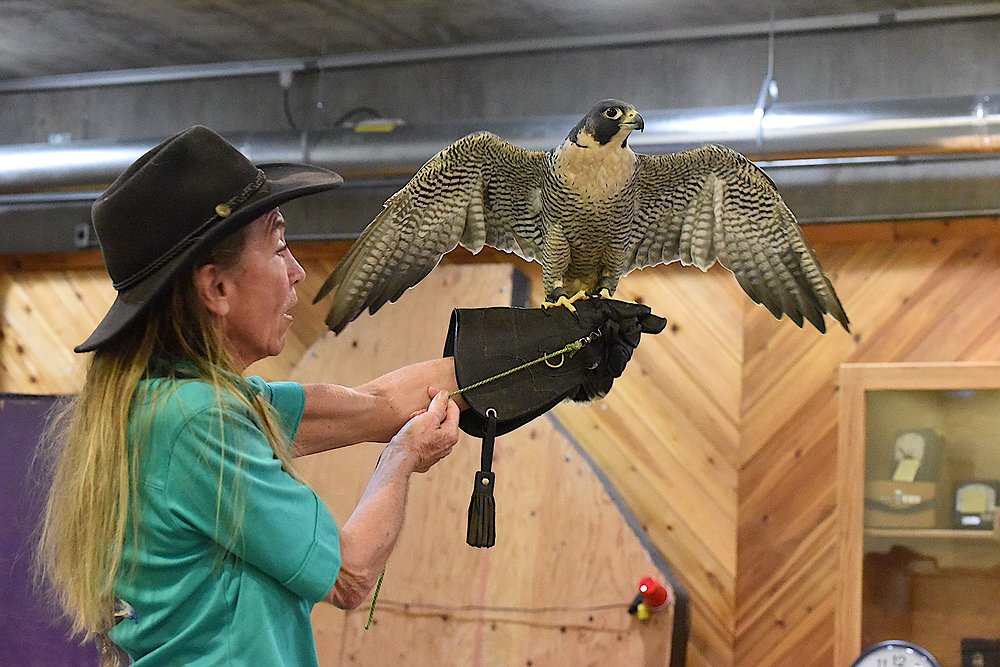Birds of prey enthrall local nature lovers
SCOTT SHINDLEDECKER | Hagadone News Network | UPDATED 1 year, 6 months AGO
They come in many sizes with coloration that matches their habitat.
Some are small enough to fit in a shirt pocket while others are large enough to prey on newborn fawns.
Birds of prey known as raptors have enthralled humans forever with their speed, hunting skill and adaptability to various environments.
A few weekends ago, nature enthusiasts got to see several winged predators when Libby Dam sponsored the Birds of Prey Northwest program. In six programs, 450 Lincoln County residents got to see a variety of two owls, a red-tailed hawk, a golden eagle and a peregrine falcon.
Based in St. Maries, Idaho, Birds of Prey Northwest is led by the wife and husband team of Janie and Don Veltkamp, who brought five raptor species.
The tiniest was a saw-whet owl named “Sawyer,” a pocket-sized night hunter. The largest was an 11-year-old golden eagle named “Dakota.”
Also part of the presentation was “Tigger,” a great horned owl, “Rusty,” an 8-year-old red-tailed hawk and “Luna,” a 7-year-old peregrine falcon.
Janie Veltkamp opened Birds of Prey Northwest and celebrated its 30th anniversary in 2023. She was trained to treat medically injured birds of prey and provide expert care at the University of Minnesota Raptor Center. She received her Masters degree in Biology from Purdue University, where her thesis investigated wintering bald eagle habitat in Indiana.
After a 36-year career in the insurance business, her husband Don joined the non-profit, which aims to educate the public about birds of prey, through on-site and virtual live raptor presentations and other expanding outreach. They also provide medical treatment to injured, sick and orphaned wild raptors with the goal of returning them to the wild.
The birds they displayed are all unable to return to the wild for various reasons.
But, as Don Veltkamp reminded, “You can’t take the wild out of ‘em.”
All were tethered and the couple wore long raptor gloves made of leather to protect themselves from the birds’ sharp talons.
They are permitted through the U.S. Fish and Wildlife Service to handle the birds.
“Our goal is to educate people about these birds of prey and get the ones we can back to the wild,” Janie Veltkamp said.
Of the five birds in the show, the saw-whet owl and golden eagle were found on the ground as a babies, taken home and fed. They became imprinted on people.
The Veltkamps have special admiration for “Rusty,” the red-tailed hawk.
“He was two weeks old when we got him. He was blown out of his nest in a 100-foot Ponderosa pine in a windstorm,” Janie Veltkamp said. “One wing was broken and the other was broke in two places.
“The veterinarian told us he probably should be put down, but I said, ‘No.’”
Janie’s desire to see the bird live was well-founded.
“God healed Rusty,” she said. “He flies as well as a wild hawk. But he’s blind in one eye and that’s why he couldn’t go back.”
While talking about the golden eagle, "Dakota," Janie Veltkamp explained why hunters should switch to using copper bullets.
"We are hunters and we made the change," she said. "Many of these birds and others die of lead poisoning after ingesting parts of animals killed by hunters.
She also talked about the recovery of the peregrine falcon and other species after the use of the insecticide DDT was banned in 1972.
"We nearly lost them because of DDT use," Veltkamp said. "At one point, there were less than 40 breeding pairs, but today there are more 2,000."
During their presentation, the couple talked of the incredible benefit the raptors provide to humankind.
“Owls and hawks kill an average of 50 mice per day,” Janie explained. “Babies can eat up to 20 mice per day and adult raptors need to eat about 25 each day.
“Their benefit to us, just eating mice, is immeasurable,” she said.
Mice can spread E. coli, which can be deadly.
Farmers are also utilizing raptors to protect their crops, including grape or cherry orchards. Falconers and their birds are used to patrol crops to keep smaller birds from destroying what they are trying to grow.
The couple also spoke of the challenges of running the rehabilitation facility.
“We don’t receive any government funding,” Janie Veltkamp said. “We depend on program fees and donations. Most of the cost is for feeding the 50 birds we have on the property. Last year, running it cost $90,000.”
For more information, see www.birdsofpreynorthwest.org.
ARTICLES BY SCOTT SHINDLEDECKER

Traffic wrecks, including a fatal, scattered across south Lincoln Co.
Law enforcement did urge motorists to slow down to poor road conditions.

Lincoln County to launch storm resource center; water still available for residents
In response to the natural disasters that have affected south Lincoln County, the county Health Department will open a Winter Storm Resource Center next week in Libby.

Two men charged after incident involving firewood
Bailey allegedly said something about the man smoking crack...







